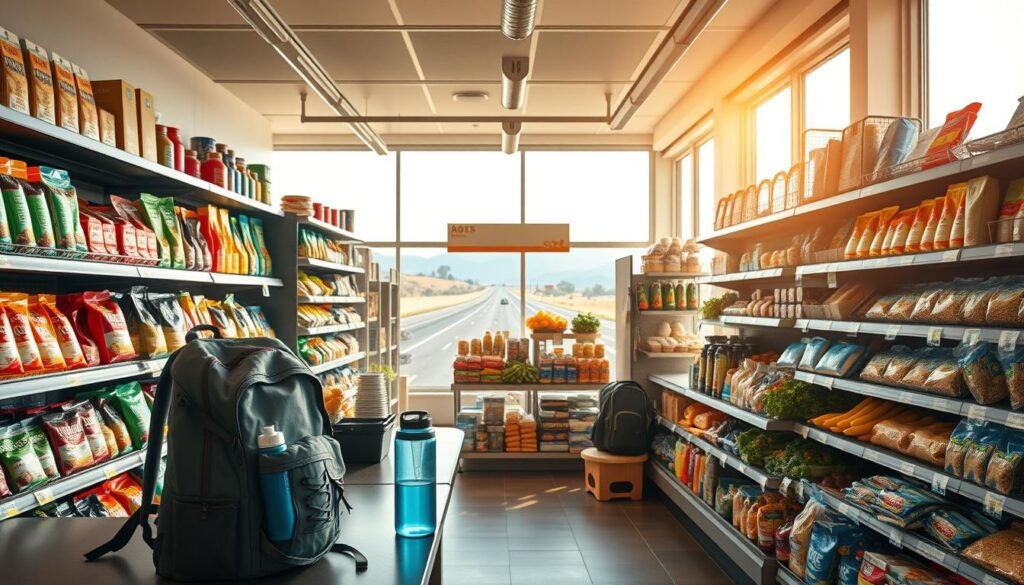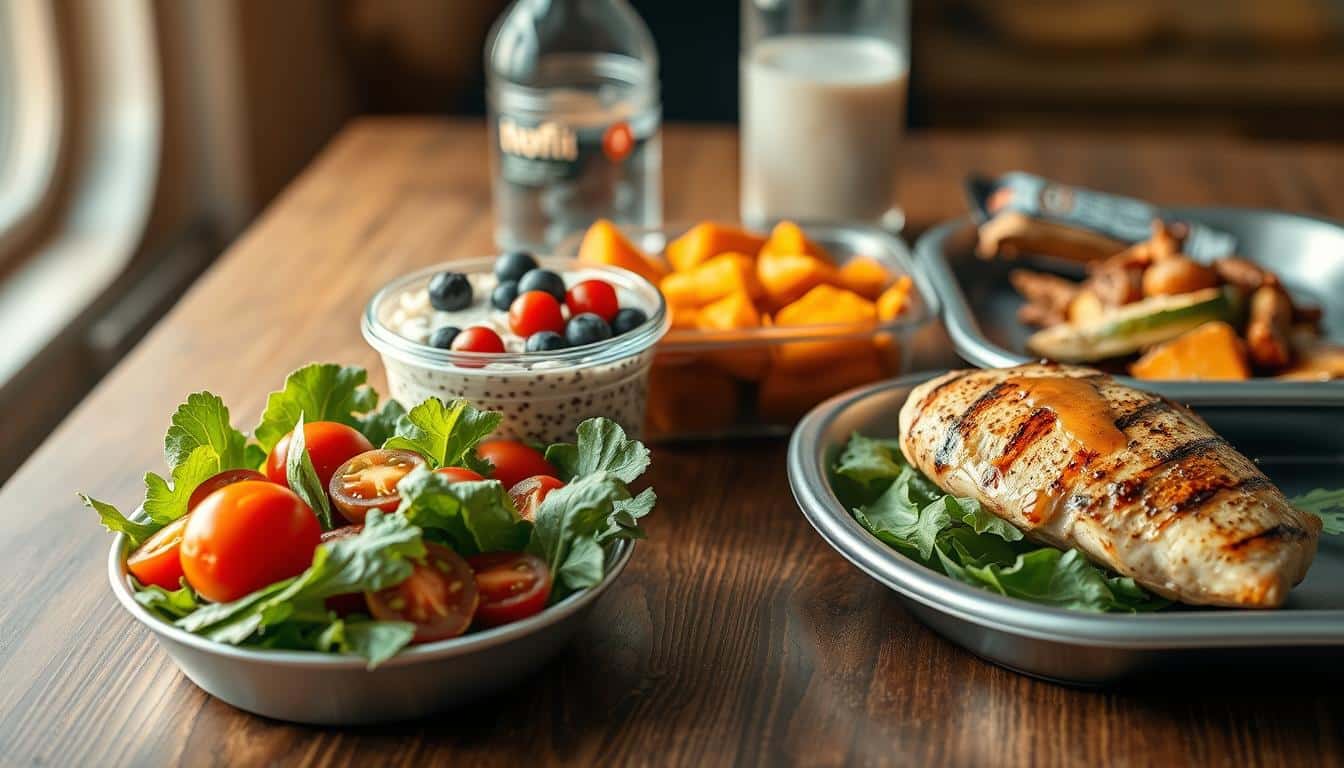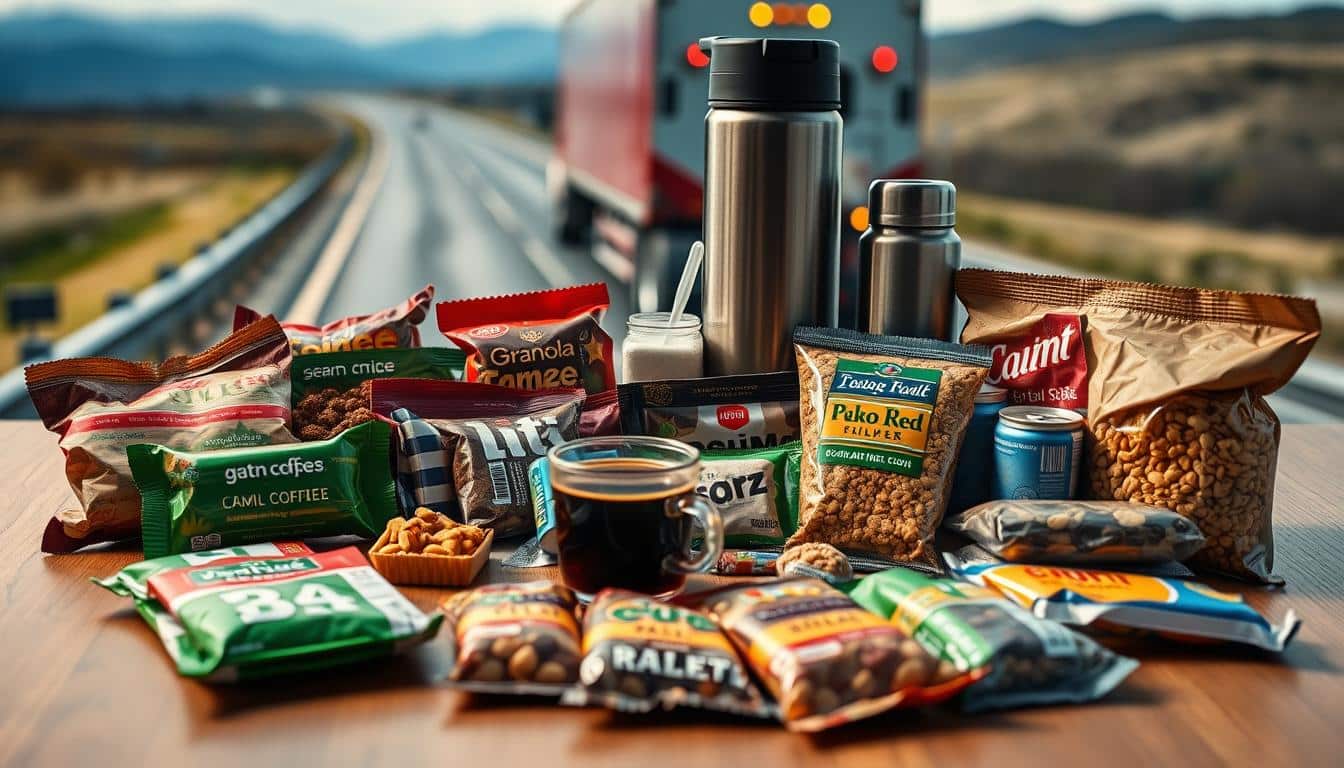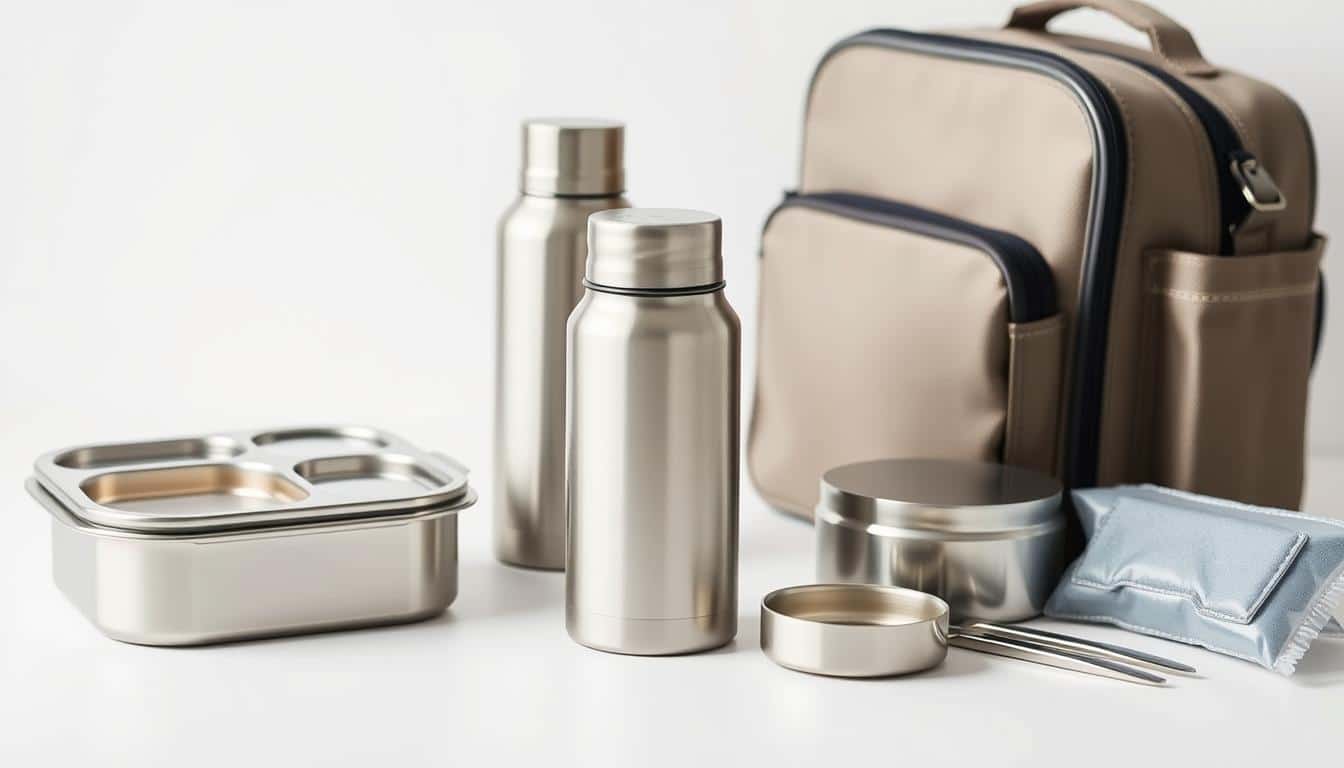Long drives need more than just coffee. Good road trip meal planning helps keep your energy up, saves money, and is better than fast-food stops. This guide offers easy, budget-friendly ideas for road trip meals and tips for staying healthy on the go, whether you’re crossing states or moving.
Mix homemade snacks like hard-boiled eggs, popcorn, and trail mix with quick supermarket finds. This keeps meals balanced with protein, fats, fiber, and enough water. Using coolers, resealable containers, and the Roadtrippers app makes eating well on the road simple and safe.
There are ideas for staying healthy whether you have access to a hotel fridge, an Airbnb kitchen, or a camp stove. Planning road meals, whether for a long trip from New York to Seattle or just a weekend journey, helps keep you alert and energized.
Why Healthy Highway Meal Prep Matters for Road Trips
Smart meal prep makes long drives easier. It keeps your energy up, reduces snack stops, and helps avoid fast food. Planning meals means you’re ready when hunger strikes.
Benefits for energy, focus, and mood while driving
Meals rich in protein, healthy fats, and fiber help avoid energy dips. Foods like hard-boiled eggs, Greek yogurt, and chicken salad keep you alert. They ensure blood sugar levels are stable.
Adding nuts and energy bites keeps your focus sharp without sugar highs. Fruits like clementines and grapes provide hydration. They offer a quick energy boost too.
Cost savings and time efficiency compared with frequent takeout
Meal prep saves money on road trips. A week’s groceries are cheaper than daily fast food.
Packing your breakfasts and snacks like trail mix or overnight oats saves time. It helps you stay on track without fast food stops.
Control over ingredients: protein, healthy fats, fiber, and hydration
Packing your meals avoids hidden sugars and bad fats in convenience foods. Choose healthy options like tuna, whole-grain wraps, and veggies for balance.
Carrying a water bottle and hydrating snacks prevents dehydration. This keeps your mind sharp. It helps with mood and comfort during long drives.
Essential Gear and Packing Tips for On-the-Road Meal Prep
Having the right gear makes it easier and safer to eat healthy on the road. It helps to have items that keep food fresh, save on space, and make cleaning up faster. Here are some useful tips for using coolers, containers, utensils, and planning tools. They help keep your food safe and lower the stress of traveling.
Coolers and ice management. For week-long journeys, a big cooler like a family-size Coleman works best. Refresh ice every two days and get rid of the water from melting ice to avoid wet food. Store protein-rich foods like hard-boiled eggs, cooked chicken, and yogurt in the cooler. In warm weather, even energy bars and baked goods should go in the cooler to stay fresh. These tips help reduce food spoilage on long trips.
- Ice packs and extras: Mix frozen gel packs with block ice for slower melting.
- Placement: Keep uncooked and ready-to-eat foods separate to avoid contamination.
Containers and portion packing. Bring sealable containers and Stasher bags for dry goods. Use zip bags for trail mix and granola portions. Big containers are great for salads or frittata pieces. Labeling containers with dates helps you keep track of freshness and avoid waste on your trip.
- Portion control: Single-serve bags are perfect for easy snacking while driving.
- Stackable solutions: Square containers help save space in your cooler.
Travel utensils and cleanup supplies. Take bamboo utensils, a small non-stick pan, dish soap, and a small sponge. Use paper towels and foil to make cleaning up easier. A small knife is useful for quick food prep. Packing these items means less stopping for takeout and faster meal times.
- Hygiene: Have hand sanitizer and bags for trash ready.
- Cookware: A cast-iron skillet or a light camp pan is best for cooking.
Planning apps and route tools. Use apps to find places to buy food, stay overnight, and plan driving time. Roadtrippers can show you where to find groceries and campsites, and suggest other roads to take. Try to drive about six hours a day when moving; four hours if you’re sightseeing. Planning well helps reduce stress and makes meals more predictable.
- Grocery timing: Stop for groceries after a long drive to get fresh food.
- Backups: Bring extra ice packs and a small cooler bag for short stops or flights.
Knowing how to manage your cooler, what containers to use, which utensils to pack, and what apps to use makes preparing food on trips easy. These steps help keep your food safe while making sure meals are delicious from the start to the end of your journey.
Highway meal prep: simple make-ahead snack ideas for travelers
Packing smart snacks can make long drives better. Here are some easy, make-ahead snacks. They save you money and time and are healthy for you. These snacks mix protein, fiber, and fresh stuff to help you avoid fast food.
High-protein picks
- Hard-boiled eggs are easy to grab and eat. Just keep them cool in a cooler.
- Tuna pouches are simple and don’t need a can opener. They’re great with whole-grain crackers.
- Greek yogurt cups or protein energy bites are good on the go. Keep them chilled.
- Ready-made bars or roasted nuts are perfect for a quick protein snack.
Fiber-forward snacks
- Homemade trail mix lets you control sugar while upping fiber. Use nuts, dried fruit, and seeds.
- Popcorn is a whole-grain snack that’s light. Choose lightly salted or seasoned bags.
- Packing grain-free or homemade granola is great for early morning or snack time.
Fresh produce that lasts
- Apples and clementines are sturdy and stay fresh. Keep them close to the cooler.
- Crispy snacks like baby carrots and mini cucumbers are perfect with dips.
- Berries and grapes are best eaten soon. Pack them in containers with air flow.
Smart pairings to balance meals
- A banana with almond butter gives you carbs and healthy fats. It keeps you full.
- Veggies with hummus or guacamole are tasty and balanced.
- Cheese with fruit or crackers is a good mix of protein and carbs. It helps with hunger.
Try dividing snacks into small bags or containers before leaving. Mix it up with homemade trail mix, fresh fruit and veggies, and protein snacks. This makes the snack bag fun and healthy for the whole trip.
No-cook meals for hotel rooms and short stops
When you’re traveling, you want quick and delicious meals without using a stove. A cooler or a trip to Walmart for some essentials is all you need. These meals are perfect for hotel rooms and require minimal prep for maximum taste.
Overnight oats and chia pudding
- Start with an overnight oats recipe: mix rolled oats, milk or plant milk, a bit of yogurt, and cinnamon. Leave it in the fridge overnight.
- Add fresh berries, banana slices, nuts, or granola for extra flavor.
- For chia pudding, mix chia seeds with milk, wait a bit, then stir and refrigerate. Both choices offer a simple breakfast without needing to heat anything.
Snack-plate dinners
- Create a snack plate with deli turkey or roast beef, several cheeses, and whole-grain crackers.
- Include pre-roasted veggies like cauliflower, squash, and some hummus or guacamole.
- Finish with nuts and fruit for a full meal that’s easy and requires no cooking.
Quick sandwiches and wraps
- Have tuna pouches ready. Mix with mayo or mustard and put it on a tortilla or bread.
- Make a roll-up of deli meat and cheese or a nut butter and banana wrap for a tasty protein snack.
- Keep tortillas and crackers on hand. They’re perfect for meals during brief stops.
Hotel room shopping hacks
- Pick up full-fat yogurt, salad kits, and pre-cooked eggs from brands like Vital Farms at big stores.
- Choose mini cucumbers and peppers that don’t need cutting. Ordering groceries to your hotel can be cheaper than room service.
- These tips help you mix and match meals for variety and nutritious eating while traveling.
Make-ahead road trip meals that travel well
Planning ahead makes long drives more enjoyable. Include both hot and cold foods that stay fresh. Choose meals with protein, fiber, and simple prep for quick stops or hotel stays.
Frittata or mini frittatas
Frittatas can be full-sized or in mini muffin forms, both rich in protein. A tray with spinach, bell peppers, and cheese offers nutritious breakfast or lunch options. You can enjoy frittata cold with fruit or heated on a camp stove.
Mason jar salads and hearty grain salads
Mason jar salads stay crisp if you layer them right. Start with dressing, add grains or beans, and finish with greens and soft toppings. Salads made with quinoa or pasta, mixed with proteins like chicken or beans, are great cold.
Chicken salad and protein-forward bowls
Make chicken salad using rotisserie or precooked chicken for an easy meal. Keep dressing on the side and cool until serving. Bowls with greens, grains, nuts, and chicken are easy to pack. They help you skip fast food.
- BLT pasta salad is tasty and holds up well. It combines bacon, tomato, and greens for a fulfilling dish.
- Summer quinoa with goat cheese and herbs is a fresh, chilled choice.
- Baked sweet potatoes are delicious hot or cold, making a great meal on their own.
- Breakfast cookies with dates are perfect for an early start, giving you energy.
Keep dressings and sauces separate and pack in strong containers to avoid messes. Chill protein-rich foods until it’s time to eat. Following these tips ensures your road trip meals are both delicious and convenient.
Meal planning strategies for multi-day trips and moving journeys
Good planning stops hunger from ruining your trip. Make a meal plan that includes Airbnb kitchens or campsite cooking days. This plan tells you when to cook, buy groceries, or eat out, following the one takeout meal rule.

One takeout meal rule
- Choose one dinner to enjoy local food each day. It’s a daily highlight that makes your money go further and lets you try local flavors without spending too much.
- For an 8-day trip, eating one takeout meal every night keeps your dining out cost around $200, assuming you choose moderately priced places.
Batch prep and ingredient multi-use
- Prepare several basic foods once: like roast chicken, brown rice, quinoa, and sweet potatoes. Then, use them in different meals: breakfasts, sandwiches, salads, and bowls.
- Pick versatile foods such as spinach, almonds, Greek yogurt, and tortillas. This reduces waste and makes meal prep easier.
Sample packing grocery list for a week-long trip
- Choose fruits that travel well, like bananas, apples, grapes, and avocados.
- Bring pantry staples: oats, peanut butter, tortillas, and tuna in cans or pouches.
- Add to the cart: mixed salad bags, cheddar cheese, a small milk jug, and trail mix.
- Don’t forget essentials like olive oil, salt, pepper, and snacks such as cinnamon, fig bars, and popcorn. Remember ice packs too.
Plan to spend about $50 on groceries before your trip, with an extra $30 for buying things while on the road. This approach fits well with a budget-friendly road trip meal strategy and helps control costs.
Practical tools and tracking
- List all meals – breakfast, lunch, snacks, and your one takeout dinner – on a plain spreadsheet or template.
- Apps like Roadtrippers track grocery stores, markets, and places to eat on your journey.
For moves, fit these methods into your food plan. It helps with packing, storing, and managing food as you travel. Smart meal planning for your trip reduces waste, saves money, and ensures everyone stays nourished and ready for adventure.
Cooking on the road: simple camp, Airbnb, and campground recipes
Kitchens on the go are usually tiny but efficient. Packing a compact stove, a nonstick pan, and some basic items lets you whip up hearty meals easily. Try these tips for quick, delicious food at a KOA, an Airbnb, or a serene campground.
For a single burner, try grilled veggie wraps or loaded baked potatoes. Grill peppers, zucchini, and onions on a rack or wrapped in foil. Then roll them up in tortillas with hummus or goat cheese for an easy, tasty wrap.
Bake potatoes or sweet potatoes in foil on a grill or coals. Add toppings like Greek yogurt, chives, shredded cheese, or chili for a fulfilling dish. Also, cooking burger patties is simple, and they go great with a fresh salad.
Airbnb cooking can be quick with the right tricks. Roast sweet potatoes whole. Stir-fry shrimp or chicken with seasoning for a protein boost. Choose easy items like pre-sliced mushrooms or cauliflower rice to avoid lots of chopping.
Leftovers can become breakfast hash. Fry up veggies in a bit of oil, add diced potatoes or cauliflower rice, and finish with an egg on top. Doing this in a nonstick pan makes cleanup a breeze.
- Pack a small camp stove and a nonstick pan for easy cooking.
- For campfire meals, a cast-iron skillet is perfect. It sears food beautifully and lasts.
- Bring containers that can also be used as bowls to reduce what you carry.
Easy cleanup keeps the journey enjoyable. Bring small dish soap, a sponge, and quick-dry towels. Lining your grill or pan with foil prevents messes.
Plan to wash dishes thoroughly every few days at places with sinks or dishwashers. If you can’t wash dishes right away, rinse and dry them to stop buildup and smells.
These ideas for on-the-go recipes and Airbnb hacks make eating well easy while traveling. Choose foods that cook fast, pack tools that have multiple uses, and pick simple recipes. This way, you save time and effort.
Healthy snacks and grocery-store hacks when you’re on the road
Smart stops can transform a long drive. Just a few items from the store can keep you going, awake, and save money. You can even make a decent meal at a motel or rest stop without needing a kitchen.

Start with a simple shopping list. Choose pre-cut veggies, single-serve hummus, tuna, and boiled eggs for protein and fiber. Places like Walmart are great in small towns when it seems like fast food is the only option.
- Convenience store healthy buys: pick up Greek yogurt, boiled eggs (look for Vital Farms), nuts, and fruit cups for quick energy.
- Walmart road trip food: find salad kits, rotisserie chicken, roasted veggies, and tortillas for easy wraps or meals.
- grocery store hacks road trip: get items like cheese, apples, and tortillas. They’re perfect for quesadillas or snacks at rest stops.
Look in the deli case for easy meals. Options like cooked meats, meatballs, and salads make quick, balanced meals. They’re great for cozy dinner in your hotel room, offering warmth and variety.
Combining simple foods can save you from expensive restaurant meals. A chicken, salad, and veggies can quickly feed two. Choose a quick grocery trip over fast food when hunger strikes.
- Budget tip: stock up on basics for breakfast and snacks. This avoids spending too much at restaurants during long trips.
- Pack small containers to divide deli food into easy-to-carry servings.
- Make quesadillas or snacks with tortillas, cheese, and apples. They’re easy and need no cooking.
You don’t need fancy equipment for road trips. With a basic list and some grocery store tips, you can eat well, save money, and enjoy your trip more.
Conclusion
Planning healthy meals for the road means a little prep, the right tools, and easy recipes. This keeps you full and focused while driving. Pack things like frittatas, salads in jars, and chicken salad. You can also bring overnight oats and snacks for variety without hassle.
Using ingredients in more than one way and preparing in batches cuts down on waste. When craving local eats, limit yourself to one takeout meal a day to stay on track. Don’t forget to bring a cooler, durable containers, and possibly a camp stove. Also, use mapping tools to find places like Walmart or delis for fresh food along the way.
Don’t leave without protein snacks like hard-boiled eggs or tuna, and foods high in fiber like trail mix and fruit. Also, pack plenty of water-rich fruits like clementines and grapes. Remember reusable containers and cleaning stuff. Following this guide helps you eat well, save money, and lower stress during your travels. It makes eating on the go easy and enjoyable.
FAQ
What should I pack in a cooler for a week-long road trip?
How do I keep perishables safe without a full kitchen or large fridge?
What are easy, no-cook breakfast options for hotel rooms?
How can I reduce stops and avoid fast-food crashes during long drives?
What are simple make-ahead meals that travel well?
Which fresh produce travels best without refrigeration?
How do I plan meals around lodging with limited kitchen access?
What gear should I bring for easy cleanup on the road?
Are grocery-store stops better than frequent takeout or room service?
How do I keep meals varied and avoid food waste on long trips?
What are quick store-bought combinations to replace a fast-food stop?
Which high-protein snacks are best for hot weather?
How much can meal prep save on a cross-country move?
What containers and packing supplies are most useful?
Can I cook on the road with minimal equipment?
What hydration strategies and foods should I include?
How should I store dressings and moist components to avoid soggy salads?
Which apps and tools help plan food stops and daily driving hours?
What are compact snack ideas that meet macronutrient balance?
Content created with the help of Artificial Intelligence.



